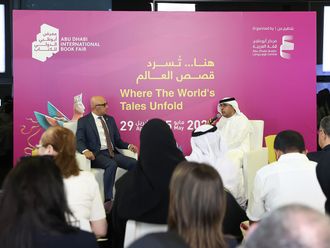Dubai: Famous iconic social media leaders from the Arab and international arena, with millions of followers across the various platforms of social media, spoke about its power to influence change and show a mirror to societies around the world.
Excerpts from their talk sessions at the Arab Social Media Influencers Summit being held in Dubai:
‘Arabizi, Arabic language’s enemy’
“In Twitter, sadly, I found that the Arab world is not using the Arabic language to tweet. The first problem is Arabic tweets are full of spelling mistakes. The second problem: the way of writing is grammatically wrong. Third and biggest problem: use of Arabizi, the biggest enemy of the Arabic language. It’s used massively and what’s worse is that search engines like Google acknowledge and support it. We must write in Arabic to increase Arabic content. It is not like the number of Arab speakers is declining. A study found that by 2050, 650 million people will be Arabic-speaking and the Unesco considers it the fourth most-spoken language, so we have to preserve it.
“Writing Arabic with mistakes is still better than writing in Arabizi, which is disrespectful of our language and culture.”
Jamal Bin Huwaireb, managing director of Mohammad Bin Rashid Al Maktoum Foundation who believes Arabizi (Arabic written in English using numbers, popularly used for chatting) is unwelcome.
‘Art of photographing strangers’
“I stop people on the streets of New York every single day, I stop them, I ask about their stories, just ordinary people. In order to get noticed, one must stand out by being different.
“This is what we’re here to talk about, how to build something amazing fast.
“Through social media, with different and good quality work, the audience expands and the work offered reaches greater masses. A lot of us share the same opinions and the same philosophies, but all of us have different stories.”
Brandon Stanton, founder of the blog ‘Humans of New York’, has over 15 million followers and believes that every individual has a story interesting enough for others to read about.
‘Instagram killed the car’
“A study found that the interest of owning cars by teens is at a decline in the US. This was something unthinkable as, since the beginning of the creation of cars, teens were interested in cars. This was because of three main reasons: first, teens not wanting to hurt the environment. Second, they wanted to share cars, and third and biggest reason, because they took a don’t text and drive lesson.
“Instead of not texting while driving, they decided to not drive a car at all! And the study found that the main reason was not because they wanted to text but they wanted to use Instagram. Because of Instagram’s game-like characteristics, it gives people feedback, so they would go every minute to check their feedback (like game points). It is fun, like games, and it involves friends.
“The negative aspects that can come out of the gamification of social media is that brands are using them.
“Before, brands would use commercials to tell us what they want us to think about their brands and we would see through them but now with the use of game applications, this is not the case.
“For example, a pizza company created an app where users can play a game where they make a pizza and at the end when they flick the pizza into the oven, it is baked in real life and delivered to their houses. This app made $1 million a week in new revenue for the company.”
Gabe Zichermann, CEO at Gasification Co. & Dopamine Inc, who spoke about how application creators have started giving their social media apps game-like characteristics to grab users’ attention.
‘My social media followers are my Kingdom’
“Before social media, us artists used to depend on journalists to send our art and views to the world. This has changed. Now, through social media, false information and rumours that used to take months and years to be denied can be cleared in seconds by a tweet shared across different platforms.
“Social media has also brought us Arabs together, I have many followers who I have never met, but I regard as my brothers and sisters. I have also gained many fans from across the world who, without social media, I would have never reached.”
Emirati singer Ahlam Al Shamsi, who has 4.5 million followers on Twitter, 4.3 million on Facebook and 2.9 million on Instagram, regards her social media followers as her Kingdom, where she receives positive energy from her fans around the world.
‘Television is there to stay for a long, long, time’
“Social media revolves around what happens on TV and even uses content from TV. Seventy per cent of the content on YouTube comes from TV so there is a great dependence on traditional media from the social media’s side.
Through social media, such as Twitter, the audience can follow tweets regarding certain events taking place on a television show that could essentially encourage them to turn it on and watch it.
“Tweets during the Arab Idol show revolve around what is happening in the episode. So there isn’t a competition [between social media and TV] because there can be cross-pollination between them.”
Ali Jaber, Dean of the Mohammad Bin Rashid School of Communication and Director of MBC Group Television, who still regards linear broadcasting as a prominent leader in the media industry. He believes social media cannot stand alone without what is viewed today as traditional media.
‘Reaching the highest point’
“After all the research, it was harder than I thought. But rather than give up, I thought, why not break it down to logical more achievable goals until [climbing] Everest became a reality.
“With social media, I was in the driver’s seat with a freedom of choice, was able to engage others throughout my journeys, could engage in conversations, it was free and effortless exposure, I was able to gain an asset and created value for sponsors.
“I started to feel like there is a message I wanted to get across especially for children, that limits that exist only exist in their own minds.”
Omar Samra, CEO and Founder of Wild Guanabana, diagnosed with asthma as a child, overcame his challenges persevering to reach his goal of climbing the highest points in the world. Through his blog and info-graphics, Samra was able to engage his followers in his journeys climbing some of the highest mountains in the world.
‘Hashtags have become the new hyperlink’
“Hashtags have become the new hyperlink, because it combines all the photos and information together and can be accessed on any platform.
“Hashtag idea, which was rejected by many people and organisations such as Twitter because they thought it can’t be used in simple online conversations is now used for global reactions and protests. For example #jan25 was used by Egyptian protesters, #bringbackourgirls was used in the global reaction of the kidnapping of almost 300 schoolgirls in Nigeria by Boko Haram, and #blackmatters, which was used by protesters of the Ferguson shooting.”
Chris Messina, creator of Hashtag, who had a rough time convincing others about the importance of hashtag in simple online conversations.












